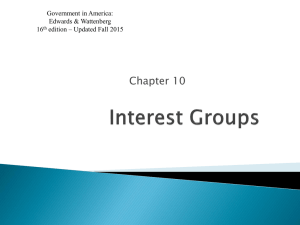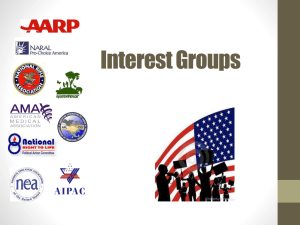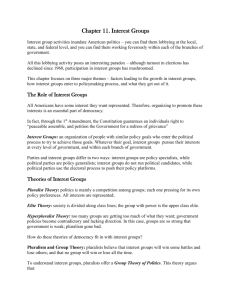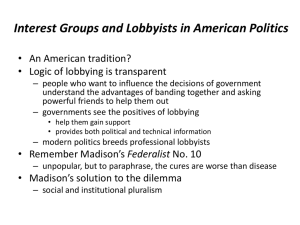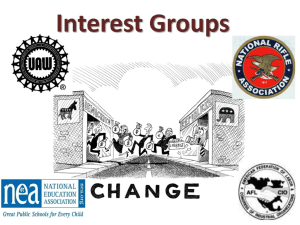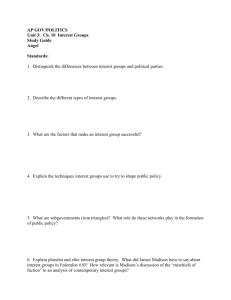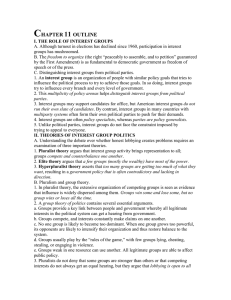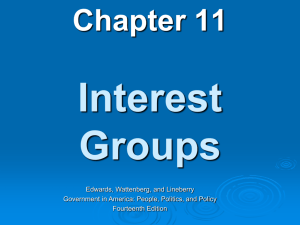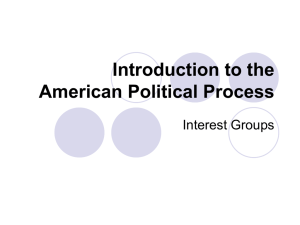Interest Groups
advertisement
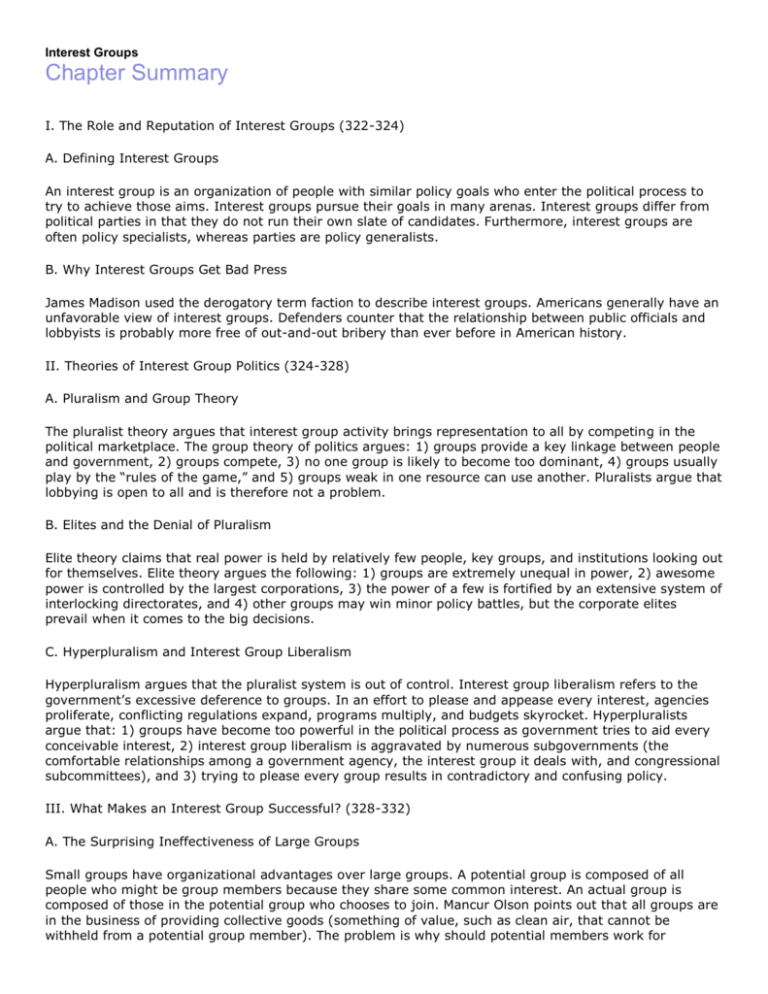
Interest Groups Chapter Summary I. The Role and Reputation of Interest Groups (322-324) A. Defining Interest Groups An interest group is an organization of people with similar policy goals who enter the political process to try to achieve those aims. Interest groups pursue their goals in many arenas. Interest groups differ from political parties in that they do not run their own slate of candidates. Furthermore, interest groups are often policy specialists, whereas parties are policy generalists. B. Why Interest Groups Get Bad Press James Madison used the derogatory term faction to describe interest groups. Americans generally have an unfavorable view of interest groups. Defenders counter that the relationship between public officials and lobbyists is probably more free of out-and-out bribery than ever before in American history. II. Theories of Interest Group Politics (324-328) A. Pluralism and Group Theory The pluralist theory argues that interest group activity brings representation to all by competing in the political marketplace. The group theory of politics argues: 1) groups provide a key linkage between people and government, 2) groups compete, 3) no one group is likely to become too dominant, 4) groups usually play by the “rules of the game,” and 5) groups weak in one resource can use another. Pluralists argue that lobbying is open to all and is therefore not a problem. B. Elites and the Denial of Pluralism Elite theory claims that real power is held by relatively few people, key groups, and institutions looking out for themselves. Elite theory argues the following: 1) groups are extremely unequal in power, 2) awesome power is controlled by the largest corporations, 3) the power of a few is fortified by an extensive system of interlocking directorates, and 4) other groups may win minor policy battles, but the corporate elites prevail when it comes to the big decisions. C. Hyperpluralism and Interest Group Liberalism Hyperpluralism argues that the pluralist system is out of control. Interest group liberalism refers to the government’s excessive deference to groups. In an effort to please and appease every interest, agencies proliferate, conflicting regulations expand, programs multiply, and budgets skyrocket. Hyperpluralists argue that: 1) groups have become too powerful in the political process as government tries to aid every conceivable interest, 2) interest group liberalism is aggravated by numerous subgovernments (the comfortable relationships among a government agency, the interest group it deals with, and congressional subcommittees), and 3) trying to please every group results in contradictory and confusing policy. III. What Makes an Interest Group Successful? (328-332) A. The Surprising Ineffectiveness of Large Groups Small groups have organizational advantages over large groups. A potential group is composed of all people who might be group members because they share some common interest. An actual group is composed of those in the potential group who chooses to join. Mancur Olson points out that all groups are in the business of providing collective goods (something of value, such as clean air, that cannot be withheld from a potential group member). The problem is why should potential members work for something if they can get it for free? This is known as the free-rider problem. The bigger the group, the more serious the free-rider problem. Olson’s law of large groups states, “the larger the group, the further it will fall short of providing an optimal amount of a collective good.” Large potential groups can overcome Olson’s law by providing attractive benefits. Selective benefits are goods that a group can restrict to those who pay their yearly dues. B. Intensity A large potential group may be mobilized through an issue that people feel intensely about, such as abortion. A single-issue group can be defined as a group that has a narrow interest, dislikes compromise, and single-mindedly pursues its goal. C. Financial Resources One of the major indictments of the American interest group system is that it is biased toward the wealthy. Critics charge that PACs distort the governmental process in favor of those that can raise the most money. Even on some of the most important issues, however, the big interests do not always win. IV. The Interest Group Explosion (332) The number of interest groups in the United States has been increasing rapidly over the last several decades. One of the reasons for the increase in the number of groups has been the development of sophisticated technology that makes it easier for groups to make their voices heard in Washington. V. How Groups Try to Shape Policy (333-339) A. Lobbying Lobbyists are political persuaders who represent organized groups. They may be paid employees of the group or hired on a temporary basis. Lobbyists are primarily out to influence members of Congress but can be of help to them as well. Lobbyists help members of Congress in five ways: 1) they are an important source of information, 2) they can help a member with political strategy, 3) they can help formulate campaign strategy, and 4) they are a source of ideas and innovations. Evidence suggests that lobbyists’ power over policy is often exaggerated, but there is evidence to suggest that sometimes lobbying can persuade legislators to support a certain policy. Lobbying clearly works best on people already committed to the lobbyist’s policy position. B. Electioneering Electioneering consists of aiding candidates financially and getting group members out to support them. Political Action Committees (PACs) have provided a means for groups to participate in electioneering. The number of PACs has grown rapidly. No major interest group seeking to influence the electoral process can pass up the opportunity to honestly and openly funnel money into the campaigns of their supporters. Only a handful of candidates have resisted the lure of PAC money in recent years. C. Litigation If interest groups fail in Congress, the next step is to go to court in the hope of getting specific rulings. Environmental groups and civil rights groups have been particularly successful in litigation. Groups employ amicus curiae briefs (briefs submitted to the courts in support of one side of a case) to influence court decisions. A more direct judicial strategy employed by interest groups is the filing of class action lawsuits, which enables a group of similarly situated plaintiffs to combine similar grievances into a single suit. D. Going Public Groups are interested in the opinions of the public. Because public opinion ultimately makes its way to policymakers, interest groups carefully cultivate their public image. The practice of interest groups’ appealing to the public for support has a long tradition in American politics. Recently, an increased number of organizations have undertaken expensive public relations efforts. VI. Types of Interest Groups (339-345) A. Economic Interests All economic interests are ultimately concerned with wages, prices, and profits. Business executives, factory workers, and farmers seek to influence government because regulations, taxes, subsidies, and international economic policy all affect their economic livelihoods. Labor has more affiliated members than any other interest group aside from the AARP. American unions press for policies to ensure better working conditions and higher wages. Unions have fought to establish the union shop, which requires new employees to join the union representing them. Business groups have supported right-to-work laws, which outlaw union membership as a condition of employment. The American labor movement reached its peak in 1956 and has declined since due to foreign competition and the decline of blue-collar industries. Only 3 percent of Americans make their living as farmers. There are several broad-based agricultural groups and commodity associations that represent farmers. Policymakers, bureaucrats, and commodity associations often provide classic examples of subgovernments. Business is well organized for political action. Business PACs have increased more dramatically than any other category of PACs. The National Association of Manufacturers and the Chamber of Congress speak for general business interests while hundreds of trade and product associations pursue policy goals for their members. B. Environmental Interests Environmental groups are among the newest political interest groups. There are over ten thousand environmental groups. They have promoted pollution-control policies, wilderness protection, and population control. The concerns of environmentalists often come into direct conflict with energy goals. C. Equality Interests Interest groups representing women and minorities have made equal rights their main policy goal. Equality at the polls, in housing, on the job, in education, and in all other facets of life has been the dominant goal of African-American groups. One of the largest is the National Association for the Advancement of Colored People (NAACP). Women’s rights groups, such as the National Organization for Women (NOW), have lobbied for an end to gender discrimination. D. Consumer and Public Interest Lobbies Today there are over two thousand public interest groups. Public interest lobbies can be defined as organizations that seek “a collective good, the achievement of which will not selectively and materially benefit the membership or activists of the organization.” Consumer groups have won many legislative victories. There are many different types of public interest groups. VII. Understanding Interest Groups (346-348) A. Interest Groups and Democracy James Madison’s solution to the problems posed by interest groups was to create a wide-open system in which many groups would be able to participate so that groups with opposing interests would counterbalance one another. One analyst concludes that the increase in lobbying activity has resulted in less clout overall for interest groups, and better democracy. Elite theorists argue that PACs, the source of money in elections, distort the process. Wealthier interests are greatly advantaged by the PAC system. Hyperpluralists argue that it has been increasingly difficult to accomplish major policy change in Washington because of the formation of so many groups. B. Interest Groups and the Scope of Government Though individualistic, Americans are also associational. By joining a number of political associations, Americans are able to politicize a variety of aspects of their own individualism. Individual interest groups fight to sustain government programs that are important to them, thereby making it hard for politicians to ever reduce the scope of government. However, one can also argue that the growth in the scope of government in recent decades accounts for a good portion of the proliferation of interest groups. The more areas in which the federal government has become involved, the more interest groups have developed to attempt to influence policy.
